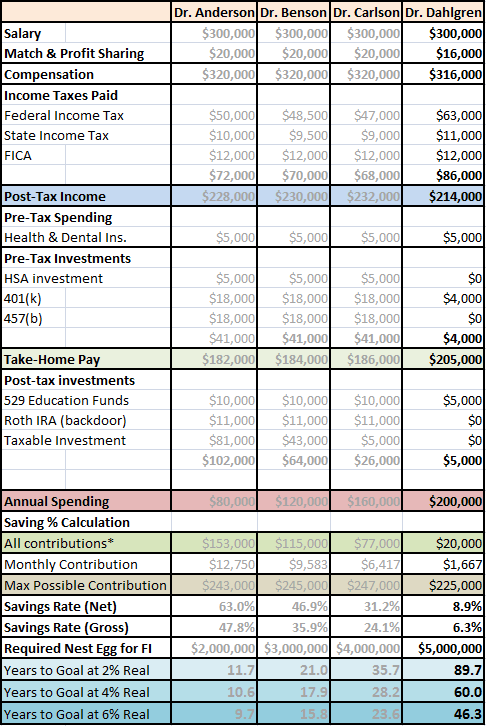A $120,000 budget put him on a reasonable track to FI, whereas it seemed he would never be able to retire on the path he was on.
4 Physicians Revisited: Dr. D & the Impact of Retiring before FI
Today, we revisit Dr. D on a good day. He just finished an awesome round at the country club, scoring as many birdies as bogies, a round that would go down as one his Top 5 of all time. His family was excited to spend a long weekend at the beach home. If it weren’t for the pesky PoF’s Excel sheets, Dr. D would be on cloud nine!
About those Excel sheets. From the initial 4 physicians post, we believe that Dr. D would have a tough time retiring and maintaining his current lifestyle. As you can see in the schedule below, with 4% returns after inflation, Dr. D was looking at a 60-year career to have 25x his expenses saved. Starting in his early-to-mid thirties, a career of that length seemed pretty unlikely.

Dr. D challenged the PoF to come up with a plan to allow him to retire at normal retirement age without altering the lifestyle that he and his wife enjoy. “What about the kids?” the PoF inquired. “Those spoiled brats? I mean, I love them dearly, but between the private school, the horse stable, and the ever-growing college funds, I’m not in love with the way we’ve handed them the good life on a silver platter,” replied Dr. Dahlgren. “Matches the spoon in their mouth, anyway,” quipped the PoF.
Challenge accepted.
Dr. D’s Current Budget
Dr. D didn’t much care about Financial Independence, or having exactly $5 million dollars. He just wanted to retire when normal people stop working, in his sixties. Looking at his expenses and budget, we can see that $5 million is actually an overestimate of his required nest egg for several small reasons, and one big one.

Even if that hefty mortgage payment was on a 30-year mortgage, it would be gone by the time Dr. D reaches a normal retirement age in his early-to-mid sixties. With the click of the delete button, we just lowered his retirement spending to $140,000.
Let’s also assume that Dr. D’s two kids were to transfer from private school to enroll in a quality public school for their remaining years, saving Dr. D an additional $10,000 a year (a conservative estimate), and that the 529 funds were allowed to grow, but additional contributions ceased. As we have done in our other revisits, we’ll make these changes 11 years after we first met the 4 physicians, enough time for Dr. A to have become financially independent.
Dr. D isn’t going to make any changes to his own standard of living, and we’ll assume that the mortgage payment doesn’t go away until he retires.
Dr. D’s Retirement Budget
During his working years, we’re only going to lower the family’s annual budget by $14,000, the cost of the private school tuition, but we’ll be lowering his nest egg requirement to match his retirement spending level of $126,000 without the $60,000 mortgage payment. The new target is 25x $126,000 = $3.15 million.
But wait! We’ve ignored social security as we often do when looking at early retirement scenarios. Dr. D won’t be retiring early, and would like to start collecting about the time he retires. He’s conservatively expecting $28,000 a year and his wife can collect half that as a $14,000 spousal benefit, so there’s $42,000 of their $126,000 spending needs. To come up with the remaining $84,000, at a 4% withdrawal rate, the new and improved target drops to 25x $84,000 = $2.1 million.

Dr. D saw his taxes drop once he maxed out the 401(k), 457(b), and HSA. His savings rates about tripled when he stopped contributing to the 529 funds (which we didn’t factor into the savings rate). The contribution to his nest egg increased from $20,000 a year to $62,000 a year.
The time to achieve the smaller nest egg decreased to a reasonable 15 to 22 years, depending on returns. The only sacrifice made was a $14,000 reduction in annual spending, in this case attributed to the cost of the private school, but it could come from any discretionary spending category. It could easily represent lower auto payments, less luxurious vacations, or the pony’s stable fees.
The 4 physicians were introduced at a point early in their careers, with a net worth of zero. Zero debts, zero assets. In real life, most physicians will hit a net worth of zero sometime in the first few years out of residency, but will have a mix of debts and assets that balance each other out.The revisits start from a point 11 years later. Assuming the docs had a net worth of zero in their mid-thirties, a reasonable assumption for many physicians, the revisits occur when they are near their mid-forties. Adding 16 to 23 years to the career puts Dr. D in his sixties at the point where he can afford to retire and maintain his relatively high standard of living.

Changing the Assumptions
Most of the improvement in Dr. D’s situation came from a change in the assumptions that more closely reflect reality when retiring at a normal retirement age. The house should be paid off, and the mortgage gone. Also, retiring in his sixties allows Dr. D to be able to count on social security.
Is social security a guarantee? Some would say no, but our nation’s retirees would be in big trouble if it were to disappear, and there are ways to shore it up pretty easily, however unpopular they might be.
One more way in which this revisit more closely reflects reality is the retirement time horizon. The 4% safe withdrawal rule assumes a 30-year retirement. Dr. D should be pretty safe retiring in his sixties, but there is more uncertainty for a doc like Dr. Anderson, who had amassed her 25 years of expenses in her forties and could live another 50 years or more.
Additionally, by retiring after age 59.5, Dr. D has full access to all his saved monies with no hassle or penalty. This is good, since Dr. D never got around to starting a taxable account. The downside is that some taxes will be due as he withdraws his funds, so another year or two of work might be worthwhile to put him in a position to cover the small but not insignificant tax burden a retiree with a high proportion of tax-deferred savings will have.
The take-home message is that having 25x expenses saved isn’t necessarily required to retire comfortably, particularly at full retirement age. Private pensions and social security can lower the required nest egg. Having the ability to cut back on expenses or downsize the home also creates some flexibility. Although Dr. D hadn’t technically met the oft-cited definition of financial independence, he was in pretty good shape to enjoy a comfortable retirement at a traditional retirement age.
What is the take-home message for you? Would you rather live like Dr. A and strive for financial independence early, or take Dr. D’s route, which seems to have a reasonable chance or working out just fine with a 30-some year career?











15 thoughts on “4 Physicians Revisited: Dr. D & the Impact of Retiring before FI”
My name is sarah williams,All thanks goes to Dr.uduebor for saving my
marriage from toning apart.i feel so grateful and only have good words
about a powerful spell caster named Dr.uduebor who helped me bring back my
husband. We had been apart for 4 months, at first I was thinking if I was
doing the right thing by contacting a spell caster, but I so much love my
husband and won’t give him up for anything in this world. I decided to
contact Dr.uduebor through his mail address I found on several testifiers
messages online,and I told him about my situation, he laughed and told me
my husband will be back to me in the next 48 hours. I felt it wasn’t going
to happen at first until my husband called me and was so eager to have me
back more than anything on earth.. Now we are together and him cant do
without me,and both of us are happy. I feel so happy sharing this testimony
because there was no negative act attached to his work. His work was smooth
and fast. Thanks to Dr.uduebor for bringing back happiness to my life. I
swear with my life that Dr.uduebor is a man to trust and take your problems
to. You can contact him on his e-mail if you really truly want your love
back.(..drudueborsolutions@gmail.com or whatsap him +2349037541959
ALSO HAS THE CURE TO THE FOLLOWING VIRUS.
1* CANCER CURE
2* HEPATITIS B
3 DIABETES CURE
4* BEAUTY SPELL
5* STROKE CURE
6* DO YOU WANT TO BE RICH
7* DO YOU NEED PROMOTED IN YOUR OFFICE
8* DO YOU NEED A CHILD
9* PENIS ENLARGEMENT
10*HIV CURE
11*BUSINESS SPELL
12*CHARM TO MAKE MEN TO LOVE YOU
Hi,
Can you help explain some of the math to me? The only change in Dr. D’s budget is to reduce his expenses by 14k per year (eliminating private school). However, he contributes 41k to his tax advantaged retirement accounts as opposed to 4k from the initial example. Minus the 5k 529 contribution that he stops making, that means he eliminates 14k from his budget but adds $35 in pre-tax retirement contributions. So where does the extra money come from? I presume tax savings but this is where I don’t understand the math. You have his federal taxes at 63k and then in the new scenario they drop down to 47k. This is a large difference. How does the math work on his tax liability being reduced so drastically? Obviously, adding 36k in pre-tax contributions will reduce his tax liability some but even at a 25% effective rate, this only eliminates 9k per year of federal taxes, you have his federal tax liability reduced by 13k.
These calculations were made using Turbotax Taxcaster before the TCJA lowered taxes across the board. At some point, I will revisit these posts and update them with the new tax calculations.
One thing to keep in mind is that contributing to tax-deferred accounts lowers your tax not by the effective tax rate, but by the marginal tax rate, which can be 50% to 100% higher than effective. When he starts contributing more the 401(k), he also gets $4k in profit sharing that he didn’t get before and the $36k in tax-deferred contributions might only cost him $19k or $20k after a $16k or $17k tax deduction.
That matches up well with cutting the $14k private school tuition and the $5k 529 contribution. With an extra $19k, he could afford to max out the 401(k) and 457(b).
Again, I’ll have to rerun the numbers as these were done in early 2016. The message of the post is that a few small tweaks, combined with a solid Social Security benefit, can lead to a comfortable retirement even without a particularly high savings rate.
Best,
-PoF
Thanks for the thoughtful response!
I am currently retired with annual expenses in the $60-75k range. Need to revisit this soon and pin it down a bit better. SS provides about $48k of this. My feeling on SS is that
sometime in the 2020s there will be phase in of decrementing SS for higher income individuals. If you look at Medicare, this has been going on for some years and 2017 marked a significant jump up in income related Part A deductions from the SS. You can
defer consideration of the impact of this for now (what may be referred to as unknown unknown ) but I feel it is inevitable as the proportion of obligatory Federal expenditures continues to rise, as predicted over the next 20 yrs. For medicare recipients, there is the
‘double whammy” that higher income individuals (about 25% of medicare recipients)
shoulder the entire load of increasing costs as those with incomes under $60k in retirement are exempt from the increased deductions that start in 2017.
Interesting. While I do expect to have some Social Security money waiting for me, I don’t factor it in to my calculations. I’ll consider it a nice bonus when the time comes. If I retire at 45, it could be 25 years before I start collecting, and I recognize that a lot can change over that long stretch of time.
Thanks for your thoughts!
-PoF
I have done a bit of Docs A-D….fortunately, I’ve stumbled into a reasonable life (for me…). I have steadily decreased expenses, and steadily increased savings…this has led me to be able to quit call (hallelujah!); and to expand into work I really enjoy (fighting fires by plane).
I wish I had learned much of this at an earlier age, but better late than never. I have found that younger folks rarely are interested in the lessons that life has taught us older ones…..
Found your blog via MMM (thank you!), and it’s great for those of us who are fortunate enough to have good incomes.
Things I would mention that I’d recommend stay “in the thought process”…
-medicine never stays the same…I had one specialty become completely economically unviable after 15 years of success. If you work hard on FIRE you have options. I was debt free, had money in the bank, and so was able to do a residency in anesthesia and “retread” into something that worked well.
-the rate of change of medicine is accelerating. Where 30 years ago, you could see change coming…today, a contract change can surprise you. More than once I’ve walked in and found that our contract wasn’t what we thought it was going to be for the next year. FIRE allows you options…..
-while “one house/one spouse” is an excellent rule….sometimes things happen you have no control over. Your spouse may decide to abuse drugs/run away. Smaller towns/hospitals occasionally have upheavals that leave you stunned…FIRE allows the option of either waiting out the trouble, or having the resources to move.
-As you set up your life, consider tax implications. If you can arrange tax-deferred contributions, or arranging things in a tax-advantaged way, more of what you earn stays with you.
-Even at the physician level, DIY can pay off. If I’m paying someone else $85/hour to do work I can do…it is like getting $150/hr for me if I DIY. They don’t tax you on money you save…(yet…)
thanks for your blog….
I’m glad you found me! It’s hilarious how we bloggers jockey for position at the top of the comments section @ MMM. I was up there until a whole bunch of people replied to the first comment. Silliness.
Fighting fires by plane. That sounds dangerously awesome. As far as jobs go, I like the one I’ve got, but I don’t know if I’ve truly loved any job I’ve ever worked, going back to stocking shelves at 16, medical research during college, and on to the present day. I’m not complaining, but I wouldn’t do the work if I wasn’t well compensated.
You’re right about the lack of control we have over all aspects of our lives. So far, so good with one spouse. Houses? I owned five at once for a brief spell. We’re down to one home and one cabin, both fully paid off. And yes, a small town hospital bankruptcy left us with one grand home and no doctors to sell it to.
I’ve done most of the legal things that can be done to reduce taxes, and I’ve written about the strategies I know. But, when you’ve got a good amount of earned income, there’s only so much that can be done. I don’t know if “the rich” are paying their fair share, but the high wage earners certainly are.
Thanks for sharing your thought with me and the growing Physician on FIRE community. Glad to have you on board!
Best,
-PoF
I love the idea of having options. We already have ditched the night and holiday shifts, and it’s literally night and day in terms of quality of life. When we reach our goal, then we’ll decide if we want to keep working, but it will be a long time until we can collect social security so for now we’re building that nest egg.
I hear cutting back is a great way to reduce burnout and start living a more fulfilling life. Congrats on creating a situation that works best for you and your family.
Cheers!
-PoF
Where would you find housing for Dr.A? 2k per month mortgage and only 3k property tax per year? I don’t think this type of housing exists. And no school loans? I think this was calculated for a different generation of doctors or maybe for rich kids who went to med school…
Thanks for the comment and question. You’re not the first person to find some of the assumptions unrealistic. Depending on where you live, they may or may not be. But truthfully, the numbers are not abnormal in many places in rural America. If Dr. A takes advantage of geographic arbitrage (higher physician’s salary and lower cost of living), she can live quite well on $80,000 a year.
For example, I am debt free, but if I had a 15-year mortgage on our primary home, it would be right around $2000 a month. Taxes are $3500 a year, but might be half that if I lived outside the city limits. A high state income tax more than makes up for the low property taxes, unfortunately. What kind of home does that get me? 2 riverfront lots with 3600 finished square feet (includes walkout basement), a 3-car detached garage and enough maple trees to get me a couple of gallons of syrup every spring. I have a 3-minute commute to the hospital by car (4 minutes by bike). Life is good up north!
True, there are some rich kids that finish medical school debt-free. I think the number is around 15% when last I checked. For this exercise, I assumed the docs had a net worth of zero. This could be done by paying off debt aggressively in the first several years of their career, balancing some debt with some assets, or being among the fortunate ones who finished residency with no debt.
“The 4 physicians were introduced at a point early in their careers, with a net worth of zero. Zero debts, zero assets. In real life, most physicians will hit a net worth of zero sometime in the first few years out of residency, but will have a mix of debts and assets that balance each other out.”
Thanks for stopping by!
Its wise to make hay whilst the sun is still shining, Getting to a position of FI and having the option to continue working or mix more trips to the Amalfi coast, is preferable to me as with each season or chapter of our lives. Our outlook tends to change as well. Plan as if you will live for a 100 years, but with the caveat that you may not be able to work as you initially hoped throughout that 30+ year span. Life is an art of hope and doing all you can today will help increase the probability of what we hope the future to be.
I agree, Dr. J. I live more like Dr. A, but I was more of a Dr. B or C in some respects when I started my career. I found this revisit to Dr. D pretty interesting. Changing the assumptions, and bumping his savings rate to 15% to 20% gave Dr. D a realistic shot at a comfortable retirement despite the big spending habits. Earning $9 million dollars over 30 years ought to be Enough, right?